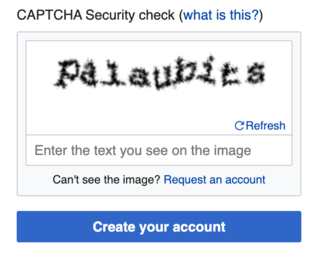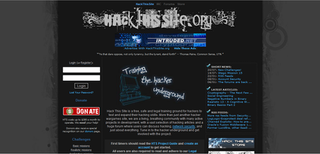Related Research Articles

A botnet is a group of Internet-connected devices, each of which runs one or more bots. Botnets can be used to perform Distributed Denial-of-Service (DDoS) attacks, steal data, send spam, and allow the attacker to access the device and its connection. The owner can control the botnet using command and control (C&C) software. The word "botnet" is a portmanteau of the words "robot" and "network". The term is usually used with a negative or malicious connotation.

Eggdrop is a popular IRC bot and the oldest that is still being maintained.

A spambot is a computer program designed to assist in the sending of spam. Spambots usually create accounts and send spam messages with them. Web hosts and website operators have responded by banning spammers, leading to an ongoing struggle between them and spammers in which spammers find new ways to evade the bans and anti-spam programs, and hosts counteract these methods.
An Internet bot, web robot, robot or simply bot, is a software application that runs automated tasks (scripts) over the Internet, usually with the intent to imitate human activity on the Internet, such as messaging, on a large scale. An Internet bot plays the client role in a client–server model whereas the server role is usually played by web servers. Internet bots are able to perform tasks, that are simple and repetitive, much faster than a person could ever do. The most extensive use of bots is for web crawling, in which an automated script fetches, analyzes and files information from web servers. More than half of all web traffic is generated by bots.
Rizon is a large Internet Relay Chat (IRC) network with an average of around 20,000 users. The IRC network itself ranks number 5 among the largest IRC networks. Rizon is popular with many anime fansubbing groups who work online, many of whom provide their content through XDCC via IRC bots in their distribution channels. It is also used by many users of eRepublik as a means of communication. File sharing of other copyrighted material such as Warez is also common in some channels on the network.
Christopher Boyd, also known by his online pseudonym Paperghost, is a computer security researcher.

HackThisSite.org, commonly referred to as HTS, is an online hacking and security website founded by Jeremy Hammond. The site is maintained by members of the community after his departure. It aims to provide users with a way to learn and practice basic and advanced "hacking" skills through a series of challenges in a safe and legal environment. The organization has a user base of over a million, though the number of active members is believed to be much lower. The most users online at the same time was 19,950 on February 5, 2018 at 2:46 a.m. CT.
Clickbot.A is a botnet that is used for click fraud.
Operation: Bot Roast is an operation by the FBI to track down bot herders, crackers, or virus coders who install malicious software on computers through the Internet without the owners' knowledge, which turns the computer into a zombie computer that then sends out spam to other computers from the compromised computer, making a botnet or network of bot infected computers. The operation was launched because the vast scale of botnet resources poses a threat to national security.
Norton AntiBot, developed by Symantec, monitored applications for damaging behavior. The application was designed to prevent computers from being hijacked and controlled by hackers. According to Symantec, over 6 million computers have been hijacked, and the majority of users are unaware of their computers being hacked.

The Storm botnet or Storm worm botnet was a remotely controlled network of "zombie" computers that had been linked by the Storm Worm, a Trojan horse spread through e-mail spam. At its height in September 2007, the Storm botnet was running on anywhere from 1 million to 50 million computer systems, and accounted for 8% of all malware on Microsoft Windows computers. It was first identified around January 2007, having been distributed by email with subjects such as "230 dead as storm batters Europe," giving it its well-known name. The botnet began to decline in late 2007, and by mid-2008 had been reduced to infecting about 85,000 computers, far less than it had infected a year earlier.

Fast flux is a domain name system (DNS) based evasion technique used by cyber criminals to hide phishing and malware delivery websites behind an ever-changing network of compromised hosts acting as reverse proxies to the backend botnet master—a bulletproof autonomous systems. It can also refer to the combination of peer-to-peer networking, distributed command and control, web-based load balancing and proxy redirection used to make malware networks more resistant to discovery and counter-measures.
Srizbi BotNet is considered one of the world's largest botnets, and responsible for sending out more than half of all the spam being sent by all the major botnets combined. The botnets consist of computers infected by the Srizbi trojan, which sent spam on command. Srizbi suffered a massive setback in November 2008 when hosting provider Janka Cartel was taken down; global spam volumes reduced up to 93% as a result of this action.

Malwarebytes Inc. is an American Internet security company that specializes in protecting home computers, smartphones, and companies from malware and other threats. It has offices in Santa Clara, California; Clearwater, Florida; Tallinn, Estonia; Bastia Umbra, Italy; and Cork, Ireland.
Zeus, ZeuS, or Zbot is a Trojan horse malware package that runs on versions of Microsoft Windows. While it can be used to carry out many malicious and criminal tasks, it is often used to steal banking information by man-in-the-browser keystroke logging and form grabbing. It is also used to install the CryptoLocker ransomware. Zeus is spread mainly through drive-by downloads and phishing schemes. First identified in July 2007 when it was used to steal information from the United States Department of Transportation, it became more widespread in March 2009. In June 2009 security company Prevx discovered that Zeus had compromised over 74,000 FTP accounts on websites of such companies as the Bank of America, NASA, Monster.com, ABC, Oracle, Play.com, Cisco, Amazon, and BusinessWeek. Similarly to Koobface, Zeus has also been used to trick victims of technical support scams into giving the scam artists money through pop-up messages that claim the user has a virus, when in reality they might have no viruses at all. The scammers may use programs such as Command prompt or Event viewer to make the user believe that their computer is infected.
The Rustock botnet was a botnet that operated from around 2006 until March 2011.
The Mariposa botnet, discovered December 2008, is a botnet mainly involved in cyberscamming and denial-of-service attacks. Before the botnet itself was dismantled on 23 December 2009, it consisted of up to 12 million unique IP addresses or up to 1 million individual zombie computers infected with the "Butterfly Bot", making it one of the largest known botnets.
ZeroAccess is a Trojan horse computer malware that affects Microsoft Windows operating systems. It is used to download other malware on an infected machine from a botnet while remaining hidden using rootkit techniques.
Linux Spike Trojan malware, more widely known as MrBlack, is a type of malware that infects routers, and eventually spreads to other routers. Incapsula, an internet security firm, first saw this malware in December 2014. This tool is prone to attack devices that still use the default credentials. A "bot" is a type of malware that allows an attacker to take control over an affected computer. Also known as "Web robots," bots are usually part of a network of infected machines, known as a "botnet," which is typically made up of victim machines that stretch across the globe.
3ve was a botnet that operated between about 2013 and 2018.
References
- ↑ Goodin, Dan. "Microsoft goes bot herder hunting in streets of Russia". www.theregister.com.
- ↑ "Bot herder | Malwarebytes Glossary". Malwarebytes.
- ↑ "Bugtraq". bugtraq.securityfocus.com.